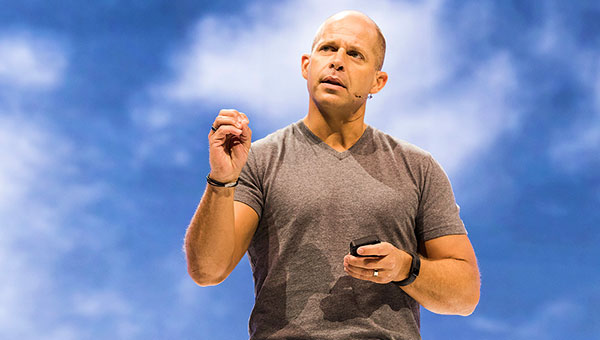Microsoft on Monday announced a slew of products and services for IT professionals and business at its first Ignite conference, being held in Chicago through Friday.
It introduced the Microsoft Azure Stack, its next-generation hybrid cloud, which lets companies’ IT departments blend enterprise software with distributed applications. It will be previewed this summer.
“Azure Stack transforms your data center infrastructure into automated resource pools that can be tailored to application service levels. This means that your app owners can quickly consume standardized IaaS/PaaS services using the same self-service experience as Azure — and they can do it through a consistent app platform that spans on-premises and Azure,” said Brad Anderson, corporate vice president, enterprise client & mobility (pictured above).
The company also released the next preview of Windows Server 2016, along with Microsoft Operations Management Suite, or OMS — a cloud-based solution that extends Systems Center 2016’s capabilities for management across almost any hybrid cloud.
Further, Microsoft introduced Windows Update for Business, a new management option for Windows 10 that will keep devices up to date with the latest security updates and Windows features.
It unveiled the technical preview of System Center Configuration Manager for Win 10, as well.
Microsoft also released Office 2016 in broad public preview — think of it as a beta release on steroids for the masses.
In addition, the company announced Skype for Business broadcasting, which lets users broadcast meetings of up to 10,000 people.
Dovetailing With Nadella’s Vision
The emphasis on the cloud ties in neatly with Microsoft CEO Satya Nadella’s vision, in which the cloud is one of the pillars of the company.
OMS “offers cloud management across Azure, AWS, Windows Server, Linux, VMware and OpenStack at a lower cost than competitive solutions,” a Microsoft spokesperson told the E-Commerce Times in a statement provided by Waggener Edstrom PR rep Chelsea Peaert.
By enabling write once, deploy anywhere across both on-premises systems and the Microsoft Azure cloud, Microsoft Azure Stack extends Azure’s ecosystem of app development and deployment into customers’ data centers in an approach that “is completely unique in the industry and gives your developers the flexibility to create applications once and then decide where to employ them later,” the spokesperson said, “with RBAC control and change tracking to meet compliance needs.”
This focus on the cloud is paying off. Microsoft had the highest revenue growth rate in the cloud infrastructure service market in Q4 2014, according to Synergy Research. However, Amazon’s AWS was still larger than Microsoft and the other top three players — IBM, Google and Salesforce.com — combined.
Securing the System
Windows Update for Business will keep devices up to date with the latest security updates and Windows features.

Its distribution rings feature lets IT pros set up separate groups of devices for staggered maintenance windows, so IT can specify when updates should and should not be rolled out; peer to peer delivery, which leverages limited bandwidth when delivering updates to branch offices and remote sites; and integration with existing tools, such as System Center and the Enterprise Mobility Suite.
“The flexibility around managing fleets of devices is a feature that IT teams in enterprises would love,” said Yaniv Karta, chief architect at Zimperium.
Part of Microsoft’s intelligent cloud, Windows Update for Business will be free for Windows Pro and Windows Enterprise devices.
“These new features allow IT more control over the Windows update process,” said Jon Rudolph, principal software engineer at Core Security.
However, enterprises have to make sure their business rollout maximizes safety while minimizing any interference with doing business. “The two goals are both essential,” Rudolph told the E-Commerce Times, but for some companies, security does not always come first.
Is Microsoft Jumping the Gun?
Could Microsoft be offering its new Windows 10 releases before the market is ready for them?
Windows 7 had more than 58 percent of the global desktop OS market in April, according to Netmarketshare. Windows XP had almost 16 percent; Windows 8.1 just over 11 percent; Windows 8 3.5 percent; and Windows Vista almost 2 percent. Apple’s OS X scored almost 6 percent, and others claimed 3.3 percent.
Consumers and enterprises are slow to upgrade their PCs, so when might these fine features introduced by Microsoft actually come into use?
“That is the billion-dollar question,” Karta told the E-Commerce Times. “Pushing a new OS will take some time. This is a game of marketing and perception.”














































Social Media
See all Social Media